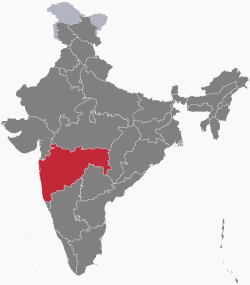Maharashtra
The administrative evolution of the state of Maharashtra is the outcome of the linguistic reorganisation of the States of India, effected on 1 May, 1960. The State was formed by bringing together all contiguous Marathi-speaking areas, which previously belonged to four different administrative hegemonies – the district between Daman and Goa that formed part of the original British Bombay Province; five districts of the Nizam’s dominion of Hyderabad; eight districts in the south of the Central Provinces (Madhya Pradesh) and a sizeable number of petty native-ruled state enclaves lying enclosed within the above areas, which later merged with adjoining districts.
Located in the north centre of Peninsular India, with the command of the Arabian Sea through its port of Mumbai, Maharashtra has a remarkable physical homogeneity, enforced by its underlying geology. The dominant physical trait of the State is its plateau character. Maharashtra is a plateau of plateaus, its western upturned rims rising to form the Sahyadri Range parallel to the sea-coast, and its slopes gently descending towards the east and south-east. Satpuda ranges cover northern part of the State, while Ajanta and Satmala ranges run through central part of the State. Arabian Sea guards the western boundary of Maharashtra, while Gujarat and Madhya Pradesh are on the northern side. Chhattisgarh covers the eastern boundary of the State. Karnataka and Andhra Pradesh are on its southern side.
| Particulars | Description |
|---|---|
 Area Area | 3,07,713 sq. km |
 Population Population | 11,23,72,972 * |
 Capital Capital | Mumbai |
 Principal Languages Principal Languages | Marathi |

|  |
Konkan Division | Nashik Division | Pune Division |
Aurangabad Division | Amravati Division | Nagpur Division |
Agriculture
About 65 per cent of the total workers in the State depend on agriculture and allied activities. Principal crops grown in the State are rice, jowar, bajra, wheat, tur, mung, urad, gram and other pulses.
Industry
The State has been identified as the country’s powerhouse and Mumbai, its capital as the centre point of India’s financial and commercial markets. Industrial sector occupies a prominent position in the economy of Maharashtra. Food products, breweries, tobacco and related products, cotton textiles, textile products, paper and paper products, printing and publishing, rubber, plastic, chemical and chemical products, machinery, electrical machinery, apparatus and appliances, and transport equipment and parts contribute substantially to the industrial production in the state.
The contribution of Industries in the State in total value of output was 18.4 per cent while that in the gross value added was about 21.4 per cent during 2008-09.
Irrigation and Power
By the end of June-2010, 32 major, 186 medium and about 2,549 state sector minor irrigation projects had been completed. Another 54 major and 72 medium irrigation projects are under construction.
Maharashtra has an installed capacity of 19,166 MV (31 December 2010) which was higher by 2.9 per cent than that on 31st March 2009. Total power generation was 81,345 million KWH in year 2009-10, which was higher by 6150 MKWH compared to previous year.
Transport
Roads:Total length of roads in the State as in March 2010 was 2.40 lakh km consisting of 4,376 km of national highways, 34,102 km of state highways, 49,621 km of major district roads, 46,817 km of other district roads, and 1,04,844 km of village roads.
Railways: Maharashtra has 5,983 km of railway routes of which is 9.4 per cent of total railway route in the country.
Aviation: There are 3 International and 5 Domestic Airports in the State. To reduce congestion in Mumbai International Airport additional Airport has been proposed at Navi Mumbai.
Ports: Mumbai is a major port. There are two major and 48 notified minor ports in the State.